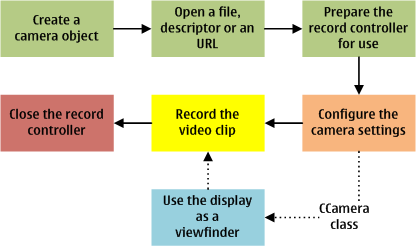Capturing a Video Clip
To record video data to a file, descriptor, or an URL, use the video recorder utility of the Multimedia Framework (MMF) to develop your application. To make use of the onboard camera to capture a video clip, the application needs to repeat the steps described in the illustration below.

Figure: The steps required to capture a video clip
Important implementation considerations include:
Make sure you include the
VideoRecorder.handmmfcontrollerpluginresolver.hheader files in the appropriate class files.Make sure you have correct capabilities information set for your application. You need at least the
UserEnvironmentcapability. If you want to set the recording priority for the video and audio device, you need theMultimediaDDcapability.Make sure
mediaclientvideo.libandmmfcontrollerframework.libare accessible to your linker when compiling your application by including it in yourmmpfile or by editing the project properties in your IDE, depending on your build environment.To open a file for recording the
CVideoRecorderUtilityclass requires the MMF Controller Framework API to specify controller and format UIDs.If you need to use the display of the device as a viewfinder for your video application, request viewfinder frames using the
CCameraclass, and draw them yourself. For more information, see step 3 in To capture still images on a mobile device .The settings you can use in your application depend on what the camera hardware on the device supports.
To capture a video clip
Use the methods of the CVideoRecorderUtility class to construct your application.
Initialize the video recorder.
Create a video recorder object using the
CVideoRecorderUtility::NewLmethod.Resolve the supported video format and retrieve a list of controllers using the
CMMFControllerPluginSelectionParametersandCMMFFormatSelectionParametersclasses, and the respective type definitionsRMMFControllerImplInfoArrayandRMMFFormatImplInfoArray.Open a file, descriptor or an URL to store the video clip in using the respective
CVideoRecorderUtility::OpenFileL,CVideoRecorderUtility::OpenDesL, orCVideoRecorderUtility::OpenUrlLmethod.Set the maximum video clip size using the
CVideoRecorderUtility::SetMaxClipSizeL()method.Prepare the record controller using the
CVideoRecorderUtility::Prepare()method.MVideoRecorderUtilityObserver::MvruoPrepareCompleteis called upon completion.
Configure the audio and video settings.
You can check and set, for example, the recording priority, audio track, video frame size and frame rate, audio and video codecs and bit rates, and recording gain of the video clip. For more information on the options, see the
CVideoRecorderUtilityclass.Capture the video clip.
Start recording a video using the
CVideoRecorderUtility::Record()method.Pause recording using the
CVideoRecorderUtility::PauseL()method.Stop recording using the
CVideoRecorderUtility::Stop()method.
To exit the application or to switch it to the background, close audio and video controllers using the
CVideoRecorderUtility::Close()method.
Additional information on capturing a video
For a reference example, see the Camera Example: Capturing and controlling the images using Camera.
For more information on CVideoRecorderUtility, see: